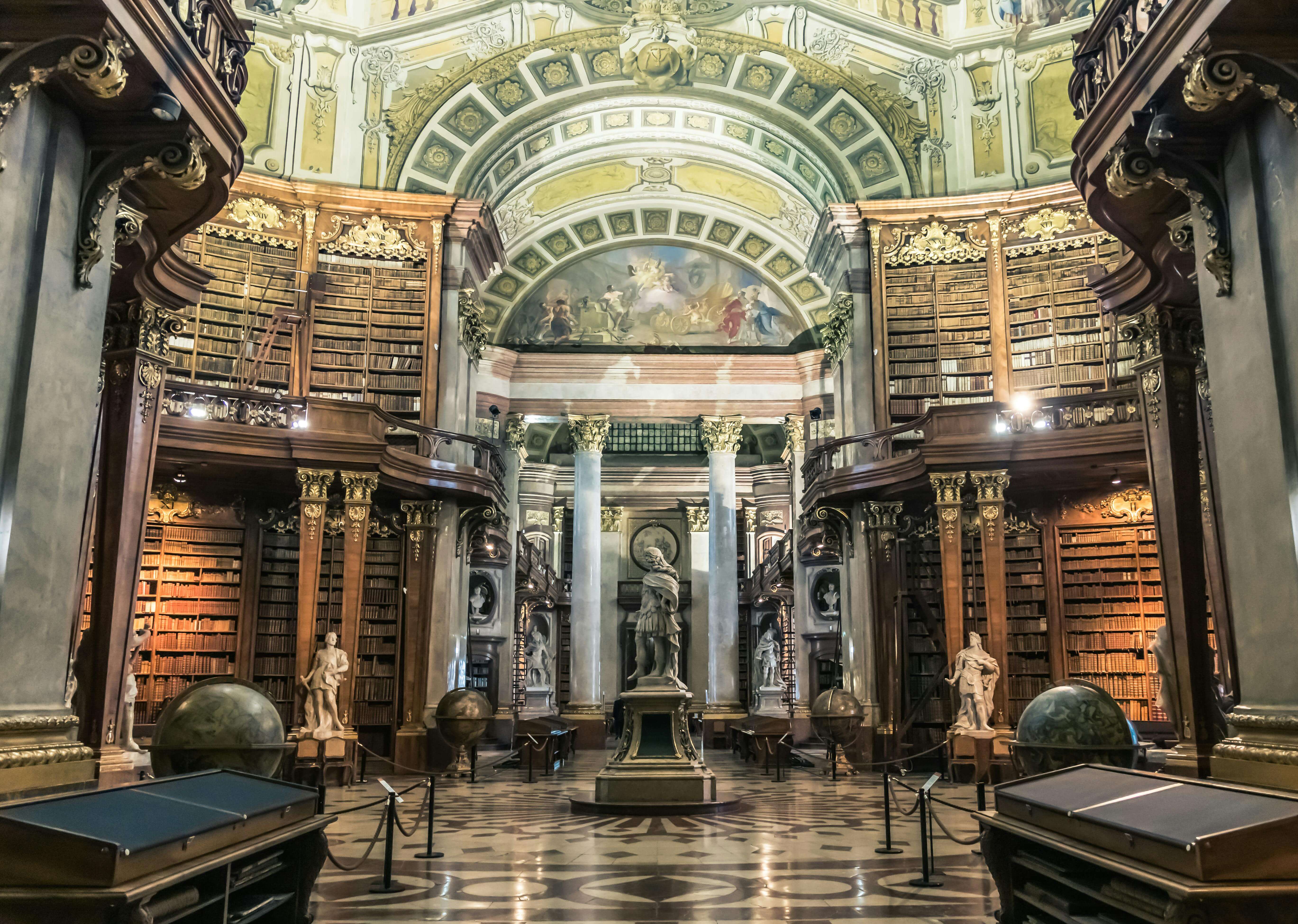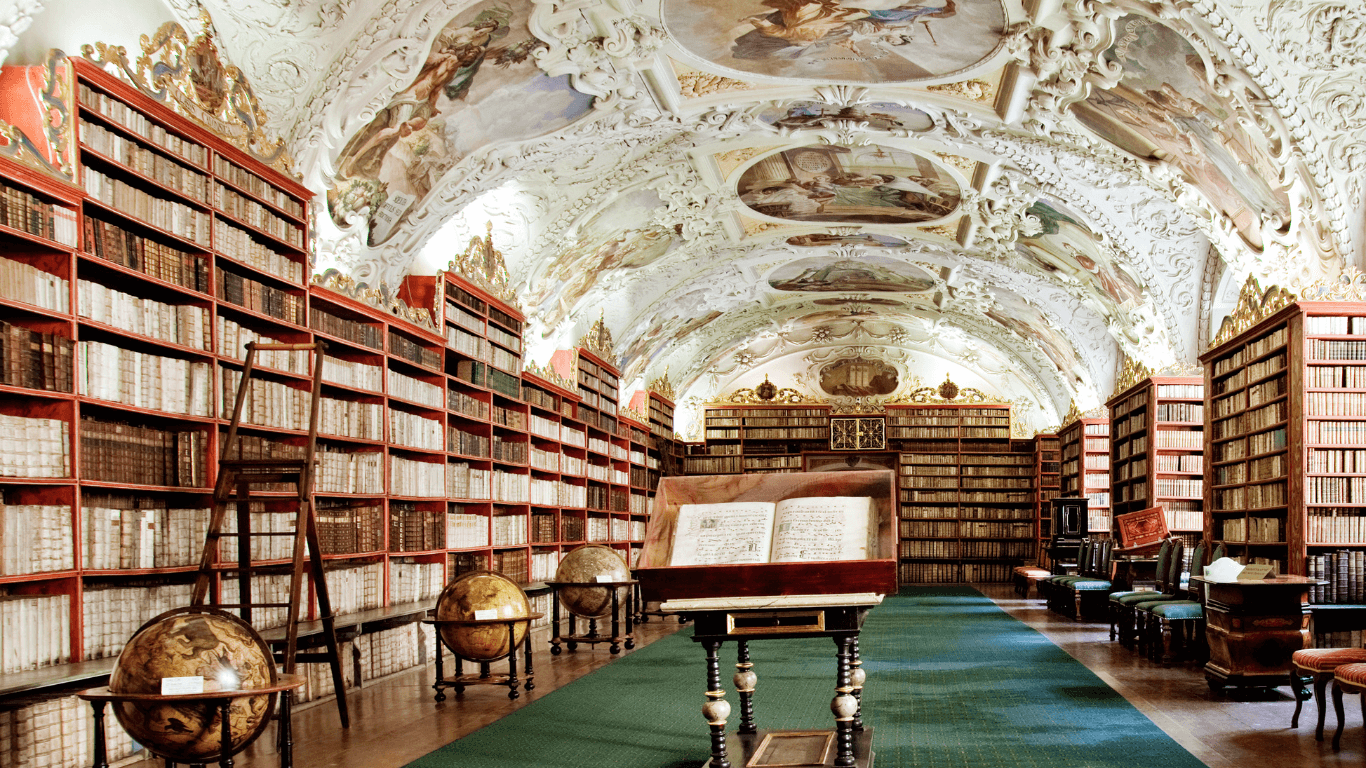Libraries are much more than merely spaces designed for storing books. They’re true temples of knowledge, places where wisdom, culture and history converge to offer visitors a unique and enriching experience. Through the centuries, these institutions have borne witness to the evolution of human thought. They serve as custodians of collective memory and intellectual inquiry.
Since their inception, libraries have played a central role in preserving knowledge, not only through their content but also through their architectural design, which often becomes a masterpiece in its own right. All over the world, there are many iconic libraries. These centres for study and research are stunning architectural masterpieces that leave a lasting impression on all who visit them. In this article, we will explore some of the world’s most iconic libraries. Their memorable designs and unique atmospheres make them spaces where knowledge and beauty blend in perfect harmony.
1. Austrian National Library – Vienna, Austria
The Austrian National Library is undoubtedly one of the most impressive and important libraries in Europe. It was founded in 1723 during the reign of Emperor Charles VI. The library’s Baroque architecture is a symbol of the grandeur of 18th-century Austrian monarchy. This imposing building is a clear reflection of the sophistication and splendour of the Baroque period. It combines Corinthian columns, ornate frescoes and other classical elements with a solemn atmosphere that evokes the power of knowledge.

One of the most striking sections of the Austrian National Library is the Rittersaal. This majestic hall renowned for the striking richness in its interior design. Ceilings painted with frescoes, gilded decorations and shelves filled with ancient manuscripts all contribute to an unforgettable visual experience. Visitors can immerse themselves in the vast collection of books, while being transported back to an era of academic splendour. The Austrian National Library is not just a place for reading and studying, but a true symbol of historical preservation and the art of knowledge.
2. Library of Congress – Washington DC, USA
The Library of Congress is one of the most influential and extensive institutions in the world in terms of content and cultural heritage. Founded in 1800, it has grown to become the largest library in the world. In fact, it houses over 170 million resources, ranging from books to rare manuscripts and historical maps. Although it is a centre for storage and preservation, its architecture is one of the most prominent and iconic in the United States capital.
The main building of the Library of Congress was designed by Thomas Jefferson. It blends neoclassical architecture with ornamental details, creating an atmosphere of solemnity and intellectual grandeur. Corinthian columns, intricate vaults and halls filled with exotic woods create an atmosphere worthy of reverence. The Main Reading Room, one of the library’s most iconic spaces, features a magnificent dome. Decorated with frescoes and stained-glass windows, it provides an immersive experience for those exploring its shelves brimming with knowledge. The Library of Congress is far more than a collection of books; it’s a living monument dedicated to preserving history and cultural diversity.
3. Vatican Library – Vatican City
The Vatican Library is a true gem for enthusiasts of knowledge and art, beautifully merging tradition, history and architecture. Founded in the 15th century, this library has been a central institution for preserving ancient manuscripts, incunabula and sacred texts. Its Renaissance and Baroque architecture is reflected in every detail, capturing centuries of ecclesiastical and academic tradition.
One of the most impressive spaces is the Hall of Maps. In addition to unique historical maps, it also features a spectacular design. Truly, the frescoes on the ceilings and walls elevate the experience to extraordinary levels. The Vatican Library is a centre of sacred knowledge, where each book seems to hold ancient secrets, and every shelf is brimming with wisdom. Furthermore, it’s a place where spirituality and academia converge to create a majestic atmosphere, where knowledge feels tangible.
4. New York Public Library – New York, United States
The New York Public Library is undoubtedly one of the most iconic cultural centres in the world. Since its opening in 1911, this Beaux-Arts building has been a symbol of erudition and art in the Big Apple. Its imposing architecture blends classical elements, such as Corinthian columns and intricate sculptures, with a majestic interior that invites reflection and deep study.
The Rose Main Reading Room is one of the most famous spaces. Together with sculpted columns, its leaded glass windows and ornate ceilings create a luxurious yet intimate atmosphere. This space is more than just a reading room; it’s a sanctuary for book lovers. Generations of thinkers have drawn inspiration for their most revolutionary ideas here. The New York Public Library is an icon, not only for its architecture but also for serving as a hub of culture, art and education in all its forms.
5. Bodleian Library – Oxford, England
The Bodleian Library in Oxford is a true treasure for scholars and academics from around the world. Founded in 1602, it has been an inexhaustible source of knowledge and wisdom for over 400 years. Interestingly, its architecture is a distinctive fusion of styles, from Gothic to Renaissance. Together, these create an atmosphere that inspires respect and reverence for knowledge.

The Radcliffe Camera, with its iconic round dome, is an instantly recognisable symbol of the library. It offers an impressive view from every angle. From the vaulted ceilings spanning its corridors and galleries to its ancient books and valuable manuscripts, visitors are immersed in an atmosphere steeped in history. The Bodleian is a living testament to the academic legacy of the University of Oxford. Every stone seems to hold a fragment of lost knowledge, and every shelf serves as a gateway to the past.
6. Strahov Library – Prague, Czech Republic
The Strahov Library in Prague is a masterpiece in its own right. Founded in 1140, this Baroque architectural work of art has stood the test of time, bearing witness to centuries with remarkable dignity. Each room feels like a journey to a bygone era. The library is decorated with intricate frescoes, hand-carved shelves, and an atmosphere that invites quiet contemplation.

One of the treasures of the Strahov Library is the Theology Hall. It is renowned for its striking frescoes and impressive collection of religious manuscripts. Indeed, this space epitomises the preservation of Christian and literary knowledge, reinforcing the library’s status as a central hub of Czech culture and history. The Strahov is a symbol of eternal knowledge, a place where art and academia meet to offer an experience that transcends time.
Conclusion
As shown above, the iconic libraries of the world are more than just buildings filled with books. They are centres of wisdom, where knowledge is preserved through the ages. Every corner is infused with history and unparalleled architectural design. Through their striking aesthetics and role as guardians of knowledge, these libraries elevate the experience of study and reading to new heights. From grand Baroque vaults to modern reading rooms, each library embodies a vital part of the intellectual and cultural legacy spanning generations. Visiting these libraries takes you to worlds where art, architecture, and literature come together in a unique harmony. Without a doubt, they leave an unforgettable impression on those fortunate enough to explore them.

